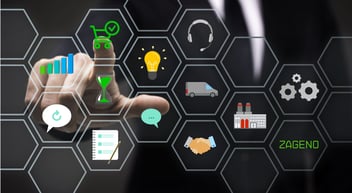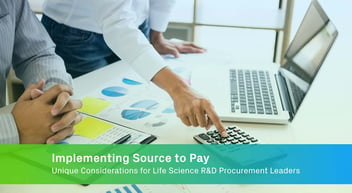While science is amazing, labs are resource-intensive, using 10 times more energy and 4 times more water than offices, and producing 5.5 million metric tons of plastic waste annually. As the urgency to combat climate change intensifies, the scientific community is leading the charge by reducing its environmental impact. One of the most effective ways is through smarter procurement practices, making strategic supply choices that advance sustainability while accelerating research and improving financial efficiency.
The importance of sustainable lab procurement
Labs rely on a vast, evolving array of supplies, from everyday consumables to specialized equipment. Traditionally, lab supply procurement has focused on cost, availability, and compliance. However, as the scientific community becomes more eco-conscious, sustainability has emerged as another key purchasing dimension.
Go deeper: Why Biotech Labs are Going Green
The hidden costs of inefficient lab supply procurement
Inefficient procurement practices can lead to significant financial and operational costs, including:
- Waste and inefficiency. Over-ordering, improper storage, and poor inventory management can result in expired or unused supplies, leading to unnecessary waste and increased costs.
- Compliance risks. In regulated industries, such as pharmaceuticals, failure to procure the correct supplies or maintain proper documentation can result in costly compliance issues.
- Supply chain disruptions. An unreliable supply chain can lead to delays in research, lost productivity, and increased operational stress.
In addition to these traditional impacts, inefficient procurement has broader environmental implications, particularly when it comes to the greenhouse gas emissions behind global warming and climate change.
Go deeper: Lab Supply Purchasing: Everything You Need to Know
Understanding lab emissions

Scope 1, 2, and 3 emissions provide a universal framework for understanding and categorizing greenhouse gas emissions and their sources. This standardized approach helps organizations comprehensively assess and manage their total greenhouse gas footprint.
- Scope 1. Direct sources of emissions. Example: If something is burned at a facility, all the resulting CO₂ and equivalent gasses fall under Scope 1.
- Scope 2. Indirect emissions from the generation of purchased electricity. Example: If oil is burned to produce electricity that is then sent to a lab or a house, the emissions from burning that oil are considered Scope 2.
- Scope 3. All other indirect emissions. Includes emissions from the production and transportation of goods, waste generation, and the carbon footprint of equipment during usage.
Each year, non-profit organization My Green Lab publishes a comprehensive annual report that explores the details of biotech and pharma’s carbon impact. One of the results of the report is that Scope 3 emissions are 4.6-fold Scope 1 and 2 combined, with the vast majority of Scope 3 emissions coming from purchased goods and services.
Practical steps to enhance sustainability in lab procurement
The good news is that lab supply procurement strategy can positively impact Scope 3 emissions, starting with the following steps:
- Engage with suppliers. Work with suppliers who are committed to sustainability and who provide detailed information about the environmental impact of their products.
- Incorporate sustainability criteria. Make sustainability a key criterion in procurement decisions. Use tools like the ACT Ecolabel* to compare products and choose those with lower carbon footprints.
- Educate lab staff. Ensure that everyone involved in procurement understands the importance of sustainable purchasing and how their choices can reduce Scope 3 emissions.
- Utilize a lab supply marketplace. Offer ordering users access to help optimize spend, reduce waste, and streamline procurement processes, all while contributing to environmental sustainability
The ACT Ecolabel: Transforming the lab product market through sustainability

The ACT Ecolabel, a program offered by My Green Lab, is specifically designed for lab consumables, chemicals, reagents, and equipment. It rates different sustainability categories and provides a score in each, enabling easier understanding of a product’s environmental impact. It includes detailed information on product composition, manufacturing location, and various sustainability factors.
Sustainability scores are color-coded using a 1 to 10 scaling system: a low number indicates a better score, while a high number indicates a poorer score. For equipment, the label provides information on energy and water consumption typical for lab use. Additionally, the Environmental Impact Factor offers a simplified overall score, where a lower number signifies a lower environmental impact. Lastly, the ACT Ecolabel is a third-party certification, ensuring the reliability, accuracy, and independence of the data on sustainability attributes.
Leveraging lab supply marketplaces for sustainability
Platforms like ZAGENO, which offers over 40 million product SKUs from 5,300 vetted global brands, are revolutionizing how labs approach procurement. ZAGENO’s AI-driven platform provides detailed product insights, enabling labs to align their purchasing decisions with sustainability goals. Benefits of accessing a lab supply marketplace include:
- Reduced environmental impact through bulk purchasing. By centralizing purchases through a marketplace, labs can take advantage of bulk buying opportunities. Bulk purchasing reduces the frequency of shipments, cutting down on transportation-related emissions and packaging waste. This not only lowers Scope 3 emissions but also contributes to more efficient and cost-effective operations.
- Transparency and supply chain management. Sustainable procurement is as much about the supply chain as it is about the products themselves. Marketplaces often include information about suppliers’ environmental practices, providing labs with access to vendors who prioritize sustainability. This transparency helps labs choose partners who align with their environmental values, ensuring that sustainability is embedded throughout the supply chain.
- Minimizing single-use plastics. One of the significant sources of waste in labs is single-use plastics. Marketplaces that emphasize sustainability often offer alternative products made from recycled materials or designed for reuse. By offering a range of eco-friendly alternatives, these platforms help labs reduce plastic waste, a major contributor to Scope 3 emissions.
Lab supply marketplaces are a powerful force in driving sustainability within the scientific community. By centralizing procurement, offering transparency, and providing access to eco-friendly products, these platforms enable labs to make informed choices that significantly reduce their Scope 3 emissions. Transitioning to sustainable lab operations isn’t just about better choices—it’s about making those choices easier, more informed, and more impactful.
Sustainability in labs is a responsibility, not an option. By integrating sustainable procurement practices, labs can dramatically reduce their environmental footprint while improving efficiency. With tools like the ACT Ecolabel and platforms like ZAGENO, labs are equipped to make smarter, greener choices. By embedding sustainability into every purchase, labs can achieve operational excellence and environmental stewardship, ensuring their contributions to science also support a healthier planet.
To learn more about how labs can improve sustainability through better procurement and lab operations, please watch ZAGENO’s recent webinar featuring My Green Lab’s Technical Program Director, Scott Weitze.




